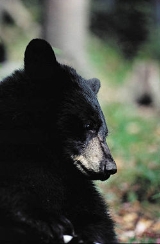
List of Massachusetts mammals
Encyclopedia
This is a list of Massachusetts mammals. It includes all mammal
s currently found in Massachusetts
, whether resident or as migrant
s. It does not include species found only in captivity. Mammal species recently presumed extinct (post 1500) are included here. Each species is listed, with its binomial name. Some species are identified as indicated below:
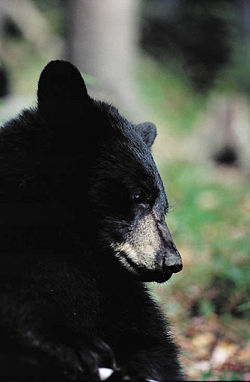
Rodent
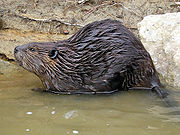
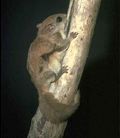
Lagomorphs
Insectivora
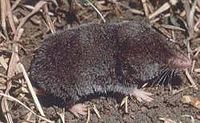
Carnivora

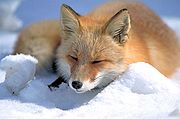
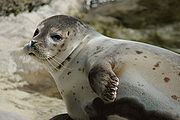
Even-toed ungulate
Cetacea

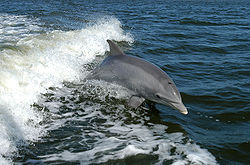
Mammal
Mammals are members of a class of air-breathing vertebrate animals characterised by the possession of endothermy, hair, three middle ear bones, and mammary glands functional in mothers with young...
s currently found in Massachusetts
Massachusetts
The Commonwealth of Massachusetts is a state in the New England region of the northeastern United States of America. It is bordered by Rhode Island and Connecticut to the south, New York to the west, and Vermont and New Hampshire to the north; at its east lies the Atlantic Ocean. As of the 2010...
, whether resident or as migrant
Animal migration
Animal migration is the relatively long-distance movement of individuals, usually on a seasonal basis. It is a ubiquitous phenomenon, found in all major animal groups, including birds, mammals, fish, reptiles, amphibians, insects, and crustaceans. The trigger for the migration may be local...
s. It does not include species found only in captivity. Mammal species recently presumed extinct (post 1500) are included here. Each species is listed, with its binomial name. Some species are identified as indicated below:
- (A) = Accidental occurrence based on one or a few records, and unlikely to occur regularly.
- (E) = ExtinctExtinctionIn biology and ecology, extinction is the end of an organism or of a group of organisms , normally a species. The moment of extinction is generally considered to be the death of the last individual of the species, although the capacity to breed and recover may have been lost before this point...
; a recent member of the avifauna that no longer exists. - (EX) = Extirpated; no longer occurs in area of interest, but other populations still exist elsewhere.
- (I) = IntroducedIntroduced speciesAn introduced species — or neozoon, alien, exotic, non-indigenous, or non-native species, or simply an introduction, is a species living outside its indigenous or native distributional range, and has arrived in an ecosystem or plant community by human activity, either deliberate or accidental...
population established solely as result of direct or indirect human intervention; synonymous with non-native and non-indigenous.

RodentRodentRodentia is an order of mammals also known as rodents, characterised by two continuously growing incisors in the upper and lower jaws which must be kept short by gnawing....
s


- American BeaverAmerican BeaverThe North American Beaver is the only species of beaver in the Americas, native to North America and introduced to South America. In the United States and Canada, where no other species of beaver occurs, it is usually simply referred to as "beaver"...
Castor canadensis - Woodland jumping mouseWoodland jumping mouseThe Woodland jumping mouse is a species of jumping mouse found in North America. It can hop surprisingly long distances given its small size. The mouse is an extraordinary part of the rodent family. Its scientific name in Latin is Napaeozapus insignis, meaning glen or wooded dell + big or strong...
Napaeozapus insignis - Meadow jumping mouseMeadow jumping mouseThe meadow jumping mouse is the most widely distributed mouse in the subfamily Zapodinae. It may be found from the Atlantic coast, to the Great Plains, as far north as the arctic tree lines in Canada and Alaska, and as far south as Georgia, Alabama, Arizona, and New Mexico.- Description :The...
Zapus hudsonius - North American PorcupineNorth American PorcupineThe North American Porcupine , also known as Canadian Porcupine or Common Porcupine, is a large rodent in the New World porcupine family. The Beaver is the only rodent larger than the North American Porcupine found in North America...
Erethizon dorsatum - Eastern Gray SquirrelEastern Gray SquirrelThe eastern gray squirrel is a tree squirrel in the genus Sciurus native to the eastern and midwestern United States, and to the southerly portions of the eastern provinces of Canada...
Sciurus carolinensis - Northern Flying SquirrelNorthern Flying SquirrelThe Northern flying squirrel is one of two species of the genus Glaucomys, the only flying squirrels found in North America . Unlike most members of their family, flying squirrels are strictly nocturnal...
Glaucomys sabrinus - Southern Flying SquirrelSouthern Flying SquirrelThe Southern Flying Squirrel is one of two species of the genus Glaucomys, the only flying squirrels found in North America . It is found in deciduous and mixed woods in the eastern half of North America, from southeastern Canada, to Florida, USA...
Glaucomys volans - Woodchuck Marmota monax
- Eastern ChipmunkEastern ChipmunkThe eastern chipmunk is a small squirrel-like rodent found in eastern North America, the sole living member of the chipmunk genus and subgenus Tamias....
Tamias striatus - Meadow VoleMeadow VoleThe Meadow Vole , sometimes called the Field Mouse or Meadow Mouse, is a North American vole found across Canada, Alaska and the northern United States. Its range extends further south along the Atlantic coast. One subspecies, the Florida Salt Marsh Vole , is found in Florida, and is classified as...
Microtus pennsylvanicus- Beach VoleBeach VoleThe Beach Vole is a species of rodent in the family Cricetidae. It is found only in the United States, and its natural habitat is temperate grassland....
Microtus p. breweri (considered by state Fish and Wildlife officials to be subspecies of Meadow Vole. Other experts consider as separate species-Microtus breweri)
- Beach Vole
- Woodland VoleWoodland VoleThe Woodland Vole, Microtus pinetorum, is a small vole found in eastern North America. It is also known as the Pine Vole.-Description:...
Microtus pinetorum - MuskratMuskratThe muskrat , the only species in genus Ondatra, is a medium-sized semi-aquatic rodent native to North America, and introduced in parts of Europe, Asia, and South America. The muskrat is found in wetlands and is a very successful animal over a wide range of climates and habitats...
Ondantra zibethicus - Southern Red-backed VoleSouthern Red-backed VoleThe Southern Red-backed Vole or Gapper's Red-backed Vole is a small slender vole found in Canada and the northern United States...
Clethrionomys gapperi - Southern Bog LemmingSouthern Bog LemmingThe Southern Bog Lemming, Synaptomys cooperi is a small North American lemming. Its range overlaps with the other species in genus Synaptomys, the Northern Bog Lemming, in southeastern Canada but extends further south....
Synaptomys cooperi - Deer Mouse Peromyscus maniculatus
- White-footed MouseWhite-footed mouseWhite-footed Mouse is a rodent native to North America. It ranges from Ontario, Quebec, Labrador and the Maritime Provinces to the southwest USA and Mexico. It is also known as the Woodmouse, particularly in Texas.Adults are in length, not counting the tail, which can add another . A young adult...
Peromyscus leucopus - Brown RatBrown RatThe brown rat, common rat, sewer rat, Hanover rat, Norway rat, Brown Norway rat, Norwegian rat, or wharf rat is one of the best known and most common rats....
Rattus norvegicus (I) - Black RatBlack RatThe black rat is a common long-tailed rodent of the genus Rattus in the subfamily Murinae . The species originated in tropical Asia and spread through the Near East in Roman times before reaching Europe by the 1st century and spreading with Europeans across the world.-Taxonomy:The black rat was...
Rattus rattus (I) - House MouseHouse mouseThe house mouse is a small rodent, a mouse, one of the most numerous species of the genus Mus.As a wild animal the house mouse mainly lives associated with humans, causing damage to crops and stored food....
Mus musculus (I)
LagomorphsLagomorphaThe lagomorphs are the members of the taxonomic order Lagomorpha, of which there are two living families, the Leporidae , and the Ochotonidae...
- Eastern CottontailEastern CottontailThe eastern cottontail is a New World cottontail rabbit, a member of the family Leporidae. It is one of the most common rabbit species in North America.-Distribution:...
Sylvilagus floridanus (I) - New England CottontailNew England CottontailThe New England Cottontail is a species of cottontail rabbit represented by fragmented populations in areas of New England, specifically from southern Maine to southern New York...
Sylvilagus transitionalis - European RabbitEuropean RabbitThe European Rabbit or Common Rabbit is a species of rabbit native to south west Europe and north west Africa . It has been widely introduced elsewhere often with devastating effects on local biodiversity...
Oryctolagus cuniculus (I) - Snowshoe HareSnowshoe HareThe Snowshoe Hare , also called the Varying Hare, or Snowshoe Rabbit, is a species of hare found in North America. It has the name "snowshoe" because of the large size of its hind feet and the marks its tail leaves. The animal's feet prevent it from sinking into the snow when it hops and walks...
Lepus americanus - European HareEuropean HareThe European hare , also known as the brown hare, Eastern Jackrabbit and Eastern prairie hare, is a species of hare native to northern, central, and western Europe and western Asia. It is a mammal adapted to temperate open country. It is related to the similarly appearing rabbit, which is in the...
Lepus europaeus (I)
InsectivoraInsectivoraThe order Insectivora is a now-abandoned biological grouping within the class of mammals...

- Star-nosed MoleStar-nosed moleThe star-nosed mole is a small mole found in wet low areas of eastern Canada and the north-eastern United States, with records extending along the Atlantic coast as far as extreme southeastern Georgia...
Condylura cristata - Hairy-tailed MoleHairy-tailed MoleThe Hairy-tailed Mole , also known as Brewer's Mole, is a medium-sized North American mole. It is the only member of the genus Parascalops....
Parascalops breweri - Eastern MoleEastern MoleThe eastern mole or common mole is a medium-sized, overall grey North American mole and the only member of the genus Scalopus. Its large, hairless, spade shaped forefeet are adapted for digging...
Scalopus aquaticus - Northern Short-tailed ShrewNorthern Short-tailed ShrewThe Northern Short-tailed Shrew is the largest shrew in the genus Blarina, and occurs in the northeastern region of North America. It is a semifossorial, highly active and voracious insectivore and is present in a variety of habitats. It is notable in that it is one of the few venomous mammals...
Sorex brevicauda - Long-tailed ShrewLong-tailed ShrewThe Long-tailed Shrew or Rock Shrew is a small North American shrew found in Atlantic Canada and the north-eastern United States....
Sorex dispar - Smoky ShrewSmoky ShrewThe Smoky Shrew, Sorex fumeus, is a medium-sized North American shrew found in eastern Canada and the northeastern United States.It is dull grey in colour with lighter underparts and a long tail which is brown on top and yellowish underneath. During winter, its fur is grey...
Sorex fumeus - American Pygmy Shrew Sorex hoyi (A)
- Northern Water Shrew Sorex palustris
- Masked ShrewMasked ShrewThe Cinereus Shrew or Masked Shrew is a small shrew found in Alaska, Canada and the northern United States. This is the most widely distributed shrew in North America where it is also known as the Common Shrew.- Description :...
Sorex cinereus
Chiroptera
- Eastern PipistrelleEastern PipistrelleThe Tricolored Bat is a species of bat that is widely distributed throughout the eastern parts of North America, ranging west until Kansas and Texas, from Honduras up north until southern Ontario...
Pipistrellus subflavus - Big Brown BatBig brown batThe Big Brown Bat is larger in size than comparative species of bats, from about 4 to 5 inches in body length, with a 11-13 inch wingspan and weighing 1/2 to 5/8 ounce. The fur is moderately long, and shiny brown...
Episticus fuscus - Eastern Red BatEastern Red BatThe Eastern Red Bat is a species of bat from the family Vespertilionidae. See also the Desert red bat , a related species....
Lasiurus borealis - Hoary BatHoary batThe hoary bat is a species of bat in the vesper bat family, Vespertilionidae. It occurs throughout most of North America and much of South America, with disjunct populations in the Galapagos and Hawaiian Islands...
Lasiurus cinereus - Eastern small-footed myotisEastern Small-footed MyotisThe Eastern Small-Footed Myotis or Eastern Small-footed Bat is a species of vesper bat in the family Vespertilionidae. It can be found in Ontario and Quebec in Canada and in the eastern United States...
Myotis leibii - Little Brown BatLittle brown batThe little brown bat is a species of the genus Myotis , one of the most common bats of North America...
Myotis lucifugus - Northern long-eared myotisNorthern long-eared myotisThe Northern long-eared myotis is a small bat, typically 5-10 g and 84 mm in total length . The fur is dull brown on the dorsum and yellowish on the venter...
Myotis septentrionalis - Indiana batIndiana batThe Indiana bat is a medium-sized mouse-eared bat native to North America. It lives primarily in eastern and midwestern states and in parts of the south of the United States. The Indiana bat is gray, black, or chestnut in colour and is 1.2–2 inches and weighs about 1/4 an ounce...
Myotis sodalis (A) - Silver-haired BatSilver-Haired BatThe Silver-haired Bat is a species of vesper bat in the family Vespertilionidae and the only member of the genus Lasionycteris.- Habitat :...
Lasionycteris noctivagans
CarnivoraCarnivoraThe diverse order Carnivora |Latin]] carō "flesh", + vorāre "to devour") includes over 260 species of placental mammals. Its members are formally referred to as carnivorans, while the word "carnivore" can refer to any meat-eating animal...
ns



- Canadian Lynx Lynx canadensis
- BobcatBobcatThe bobcat is a North American mammal of the cat family Felidae, appearing during the Irvingtonian stage of around 1.8 million years ago . With twelve recognized subspecies, it ranges from southern Canada to northern Mexico, including most of the continental United States...
Lynx rufus - Mountain Lion Puma concolor (EX)
- CoyoteCoyoteThe coyote , also known as the American jackal or the prairie wolf, is a species of canine found throughout North and Central America, ranging from Panama in the south, north through Mexico, the United States and Canada...
Canis latrans - Gray WolfGray WolfThe gray wolf , also known as the wolf, is the largest extant wild member of the Canidae family...
Canis lupus (EX) - Red FoxRed FoxThe red fox is the largest of the true foxes, as well as being the most geographically spread member of the Carnivora, being distributed across the entire northern hemisphere from the Arctic Circle to North Africa, Central America, and the steppes of Asia...
Vulpes vulpes - Common Gray Fox Urocyon cineroargentatus
- Black BearAmerican black bearThe American black bear is a medium-sized bear native to North America. It is the continent's smallest and most common bear species. Black bears are omnivores, with their diets varying greatly depending on season and location. They typically live in largely forested areas, but do leave forests in...
Ursus americanus - Common Raccoon Procyon lotor
- Northern River OtterNorthern River OtterThe North American river otter , also known as the northern river otter or the common otter, is a semiaquatic mammal endemic to the North American continent, found in and along its waterways and coasts. An adult river otter can weigh between 5 and 14 kg...
Lontra canadensis - WolverineWolverineThe wolverine, pronounced , Gulo gulo , also referred to as glutton, carcajou, skunk bear, or quickhatch, is the largest land-dwelling species of the family Mustelidae . It is a stocky and muscular carnivore, more closely resembling a small bear than other mustelids...
Gulo gulo - American MartenAmerican MartenThe American marten is a North American member of the family Mustelidae, sometimes referred to as the pine marten. The name "pine marten" is derived from the common but distinct Eurasian species of Martes...
Martes americana - FisherFisher (animal)The fisher is a medium-size mammal native to North America. It is a member of the mustelid family, commonly referred to as the weasel family. The fisher is closely related to but larger than the American Marten...
Martes pennanti - ErmineErmineErmine has several uses:* A common name for the stoat * The white fur and black tail end of this animal, which is historically worn by and associated with royalty and high officials...
Mustela erminea - Long-tailed WeaselLong-tailed WeaselThe long-tailed weasel , also known as the bridled weasel or big stoat is a species of mustelid distributed from southern Canada throughout all the United States and Mexico, southward through all of Central America and into northern South America.-Evolution:The long-tailed weasel is the product of...
Mustela frenata - American MinkAmerican MinkThe American mink is a semi-aquatic species of Mustelid native to North America, though human intervention has expanded its range to many parts of Europe and South America. Because of this, it is classed as Least Concern by the IUCN. Since the extinction of the sea mink, the American mink is the...
Mustela vison- Sea MinkSea MinkThe Sea Mink, Neovison macrodon, is an extinct North American member of the family Mustelidae. It is the only mustelid, and one of only two terrestrial mammal species in the order Carnivora, to become extinct in historic times . The body of the sea mink was significantly longer than that of the...
Mustela v. macrodon(considered here to be subspecies of American Mink. Other experts consider as separate species-Mustela macrodon) (E)
- Sea Mink
- Striped SkunkStriped SkunkThe striped skunk, Mephitis mephitis, is an omnivorous mammal of the skunk family Mephitidae. Found over most of the North American continent north of Mexico, it is one of the best-known mammals in Canada and the United States.-Description:...
Mephitis mephitis - WalrusWalrusThe walrus is a large flippered marine mammal with a discontinuous circumpolar distribution in the Arctic Ocean and sub-Arctic seas of the Northern Hemisphere. The walrus is the only living species in the Odobenidae family and Odobenus genus. It is subdivided into three subspecies: the Atlantic...
Odobenus rosmarus (A) - Bearded SealBearded SealThe bearded seal , also called the square flipper seal, is a medium-sized pinniped that is found in and near to the Arctic Ocean. It gets its generic name from two Greek words that refer to its heavy jaw...
Erignathus barbatus (A) - Hooded SealHooded SealThe hooded seal is an arctic pinniped found only in the central and western North Atlantic ranging from Svalbard in the east to the Gulf of St...
Cystophora cristata (A) - Harbor SealHarbor SealThe harbor seal , also known as the common seal, is a true seal found along temperate and Arctic marine coastlines of the Northern Hemisphere...
Phoca vitulina - Ringed SealRinged SealThe ringed seal , also known as the jar seal and as netsik or nattiq by the Inuit, is an earless seal inhabiting the Arctic and sub-Arctic regions...
Phoca hispida (A) - Harp SealHarp SealThe harp seal or saddleback seal is a species of earless seal native to the northernmost Atlantic Ocean and adjacent parts of the Arctic Ocean. It now belongs to the monotypic genus Pagophilus. Its scientific name, Pagophilus groenlandicus, means "ice-lover from Greenland", and its synonym, Phoca...
Phoca groenlandica (A) - Gray Seal Halichoerus grypus
Even-toed ungulateEven-toed ungulateThe even-toed ungulates are ungulates whose weight is borne about equally by the third and fourth toes, rather than mostly or entirely by the third as in odd-toed ungulates such as horses....
s
- ElkElkThe Elk is the large deer, also called Cervus canadensis or wapiti, of North America and eastern Asia.Elk may also refer to:Other antlered mammals:...
Cervus canadensis (EX) - MooseMooseThe moose or Eurasian elk is the largest extant species in the deer family. Moose are distinguished by the palmate antlers of the males; other members of the family have antlers with a dendritic configuration...
Alces alces - Fallow DeerFallow DeerThe Fallow Deer is a ruminant mammal belonging to the family Cervidae. This common species is native to western Eurasia, but has been introduced widely elsewhere. It often includes the rarer Persian Fallow Deer as a subspecies , while others treat it as an entirely different species The Fallow...
Dama dama (I) - White-tailed DeerWhite-tailed DeerThe white-tailed deer , also known as the Virginia deer or simply as the whitetail, is a medium-sized deer native to the United States , Canada, Mexico, Central America, and South America as far south as Peru...
Odocoileus virginianus
CetaceaCetaceaThe order Cetacea includes the marine mammals commonly known as whales, dolphins, and porpoises. Cetus is Latin and is used in biological names to mean "whale"; its original meaning, "large sea animal", was more general. It comes from Ancient Greek , meaning "whale" or "any huge fish or sea...


- Fin WhaleFin WhaleThe fin whale , also called the finback whale, razorback, or common rorqual, is a marine mammal belonging to the suborder of baleen whales. It is the second longest whale and the sixth largest living animal after the blue whale, bowhead whale, and right whales, growing to nearly 27 metres long...
Balaenoptera physalus - Blue WhaleBlue WhaleThe blue whale is a marine mammal belonging to the suborder of baleen whales . At in length and or more in weight, it is the largest known animal to have ever existed....
Balaenoptera musculus - Sei WhaleSei WhaleThe sei whale , Balaenoptera borealis, is a baleen whale, the third-largest rorqual after the blue whale and the fin whale. It inhabits most oceans and adjoining seas, and prefers deep offshore waters. It avoids polar and tropical waters and semi-enclosed bodies of water...
Balaenoptera borealis - Minke WhaleMinke WhaleMinke whale , or lesser rorqual, is a name given to two species of marine mammal belonging to a clade within the suborder of baleen whales. The minke whale was given its official designation by Lacepède in 1804, who described a dwarf form of Balænoptera acuto-rostrata...
Balaenoptera acutorostrata - Humpback WhaleHumpback WhaleThe humpback whale is a species of baleen whale. One of the larger rorqual species, adults range in length from and weigh approximately . The humpback has a distinctive body shape, with unusually long pectoral fins and a knobbly head. It is an acrobatic animal, often breaching and slapping the...
Megaptera novaeangliae - Gray WhaleGray WhaleThe gray whale, Eschrichtius robustus, is a baleen whale that migrates between feeding and breeding grounds yearly. It reaches a length of about , a weight of , and lives 50–70 years. The common name of the whale comes from the gray patches and white mottling on its dark skin. Gray whales were...
Eschrichtius robustus (ex) - North Atlantic Right WhaleNorth Atlantic Right WhaleThe North Atlantic right whale which means "good, or true, whale of the ice") is a baleen whale, one of three right whale species belonging to the genus Eubalaena, formerly classified as a single species. With only 400 in existence, North Atlantic right whales are among the most endangered whales...
Eubalaena glacialis - Sperm WhaleSperm WhaleThe sperm whale, Physeter macrocephalus, is a marine mammal species, order Cetacea, a toothed whale having the largest brain of any animal. The name comes from the milky-white waxy substance, spermaceti, found in the animal's head. The sperm whale is the only living member of genus Physeter...
Physeter macrocephalus - Pygmy Sperm WhalePygmy Sperm WhaleThe Pygmy Sperm Whale is one of three species of toothed whale in the sperm whale family. They are not often sighted at sea, and most of what is known about them comes from the examination of stranded specimens.-Taxonomy:...
Kogia breviceps - Northern Bottlenose Whale Hyperoodon ampullatus
- Sowerby's Beaked WhaleSowerby's Beaked WhaleSowerby's beaked whale , also known as the North Atlantic/North Sea beaked whale, was the first beaked whale to be described. James Sowerby, an English naturalist and artist, first described the species in 1804 from a skull obtained from a male that had stranded in the Moray Firth, Scotland, in 1800...
Mesplodon bidens - Blainville's Beaked WhaleBlainville's Beaked WhaleBlainville's beaked whale , or the dense-beaked whale, is the widest ranging mesoplodont whale and perhaps the most documented. Henri de Blainville first described the species in 1817 from a small piece of jaw—the heaviest bone he had ever come across—which resulted in the name densirostris...
Mesplodon densirostris - Gervais' Beaked WhaleGervais' Beaked WhaleGervais' beaked whale , sometimes known as the Antillian beaked whale, Gulf Stream beaked whale, or European beaked whale is the most frequently stranding type of mesoplodont whale off the coast of North America...
Mesplodon europaeus (A) - True's Beaked WhaleTrue's Beaked WhaleThe True's Beaked Whale is a medium sized whale in the Mesoplodont genus. The common name is in reference to Frederick W. True, a curator at the United States National Museum...
Mesplodon mirus - Cuvier's Beaked WhaleCuvier's Beaked WhaleCuvier's beaked whale is the most widely distributed of all the beaked whales. It is the only member of the genus Ziphius. Another common name for the species is goose-beaked whale because its head is said to be shaped like the beak of a goose. Georges Cuvier first described it in 1823 from part...
Ziphius cavirostris - Beluga Delphinapterus leucas (A)
- Short-beaked Common DolphinShort-beaked Common DolphinThe short-beaked common dolphin is a species of common dolphin. It has a larger range than the long-beaked common dolphin , occurring throughout warm-temperate and tropical oceans, with the possible exception of the Indian Ocean...
Delphinus delphis - Short-finned Pilot WhaleShort-finned Pilot WhaleThe Short-finned Pilot Whale is one of the two species of cetacean in the genus Globicephala. It is part of the oceanic dolphin family , though its behaviour is closer to that of the larger whales....
Globicephala macrorhynchus (A) - Long-finned Pilot WhaleLong-finned Pilot WhaleThe long-finned pilot whale is one of the two species of cetacean in the genus Globicephala. It belongs to the oceanic dolphin family , though its behavior is closer to that of the larger whales.-Description:...
Globicephala melas - Risso's DolphinRisso's DolphinRisso's dolphin is the only species of dolphin in the genus Grampus.-Taxonomy:Risso's dolphin is named after Antoine Risso, whose description formed the basis of the first public description of the animal, by Georges Cuvier, in 1812...
Grampus griseus - Atlantic White-sided DolphinAtlantic White-sided DolphinThe Atlantic White-sided Dolphin is a distinctively coloured dolphin found in the cool to temperate waters of the North Atlantic Ocean.-Taxonomy:...
Lagenorhynchus acutus - White-beaked DolphinWhite-beaked DolphinThe White-beaked dolphin is a marine mammal belonging to the family Delphinidae in the suborder Odontoceti .-Taxonomy:...
Lagenorhynchus albirostris - Killer Whale Orcinus orca
- False Killer WhaleFalse Killer WhaleThe False Killer Whale is a cetacean, and the third largest member of the oceanic dolphin family . It lives in temperate and tropical waters throughout the world. As its name implies, the False Killer Whale shares characteristics, such as appearance, with the more widely known Orca...
Pseudorca crassidens (A) - Pantropical Spotted DolphinPantropical Spotted DolphinThe Pantropical Spotted Dolphin is a species of dolphin found in all the world's temperate and tropical oceans. The species was beginning to come under threat due to the killing of millions of individuals in tuna purse seines...
Stenella attenuata (A) - Striped DolphinStriped DolphinThe Striped Dolphin is an extensively studied dolphin that is found in temperate and tropical waters of all the world's oceans.-Taxonomy:...
Stenella coeruleoalba - Atlantic Spotted DolphinAtlantic Spotted DolphinThe Atlantic Spotted Dolphin is a dolphin found in the Gulf Stream of the North Atlantic Ocean. Older members of the species have a very distinctive spotted coloration all over their body.-Taxonomy:...
Stenella fontalis - Bottlenose DolphinBottlenose DolphinBottlenose dolphins, the genus Tursiops, are the most common and well-known members of the family Delphinidae, the family of oceanic dolphins. Recent molecular studies show the genus contains two species, the common bottlenose dolphin and the Indo-Pacific bottlenose dolphin , instead of one...
Tursiops truncatus - Harbor Porpoise Phocoena phocoena
See also
- Mammals of New EnglandMammals of New EnglandThere are 7 orders, 17 families, 40 genera, and 60 species represented among the Mammals of New England. If extirpated, coastal, introduced, and accidental species are included these numbers increase to 8 orders, 26 families, 67 genera, and 105 species. The region includes the U.S...
- List of Massachusetts birds
- List of mammals
- List of regional mammals lists
- List of mammals in Connecticut
- List of mammals in North America

